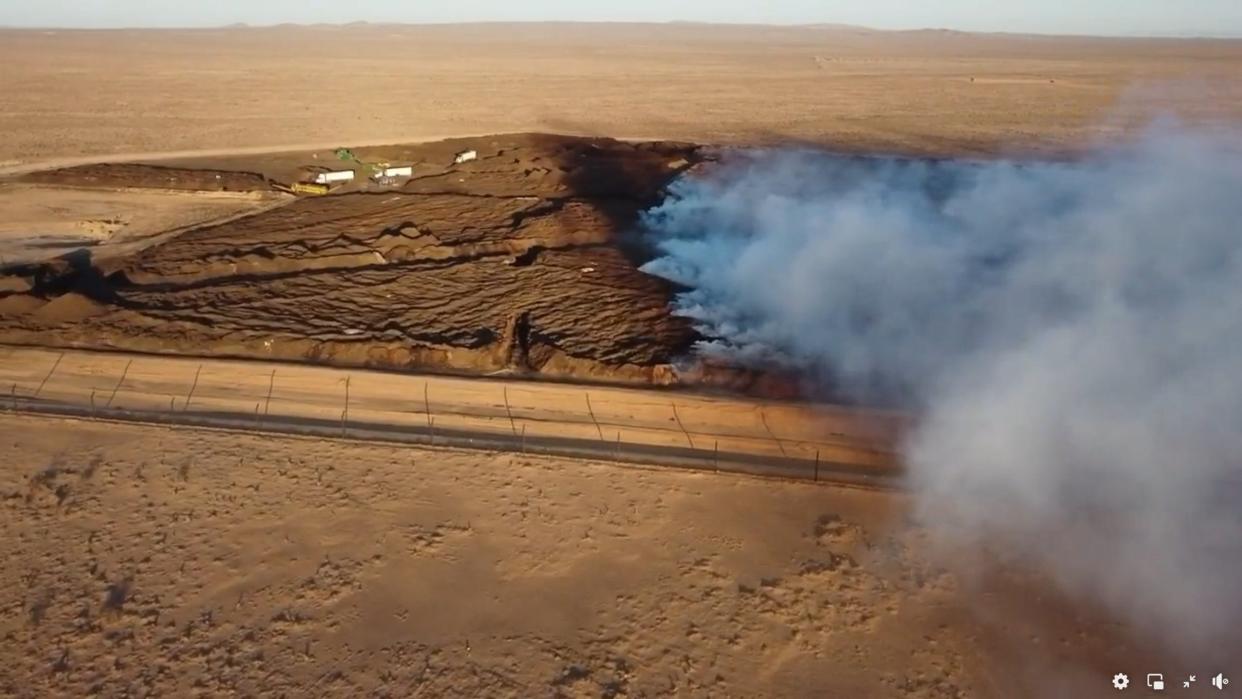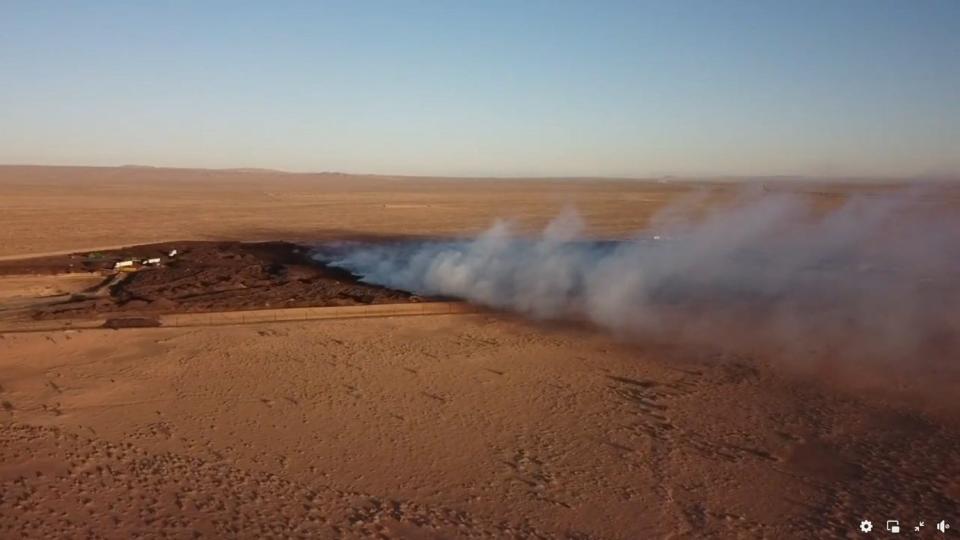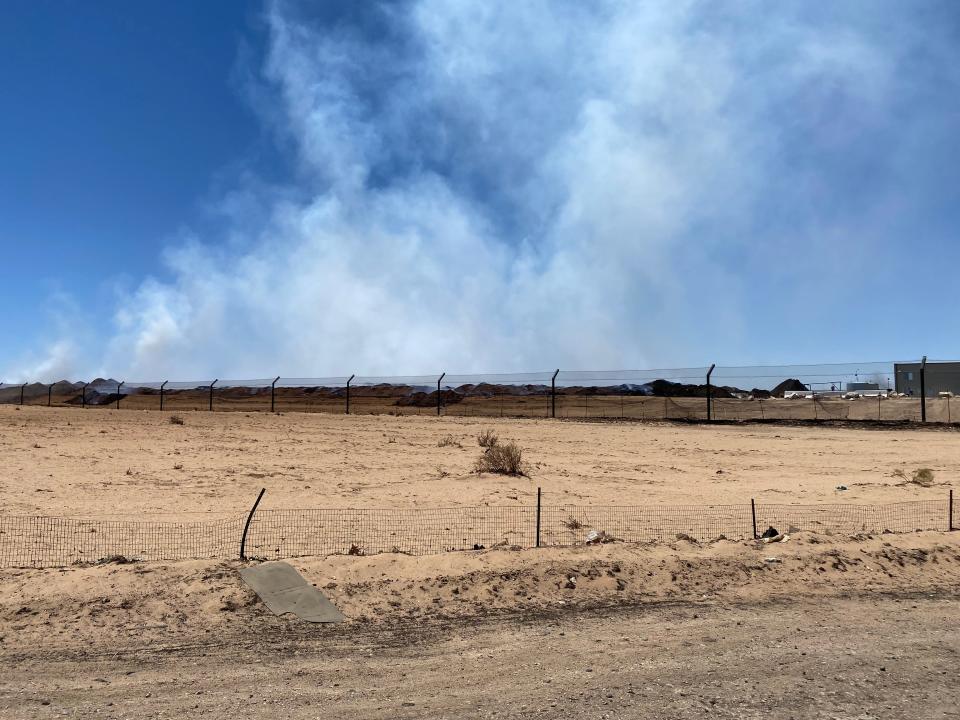‘Smell of death’: Health concerns arise as 80-acre High Desert waste pit burns

Animals dropping dead en masse. Breathing disruptions to the point of emergency-room stays for asthmatics. Burning eyes. Nonstop headaches.
“The smell of crap, but also the smell of death,” as Hinkley resident Contessa Orsini describes it.
High Desert residents say all these afflictions are coming from a fire that erupted sometime in late May within an 80-acre pit of waste at the Nursery Products Hawes Composting Facility. This massive industrial site directly neighbors the sparse but storied town of Hinkley, and sits not much farther from other rural towns and wildlife vulnerable to environmental strains.
More: The Daily Press stories you want, delivered to your inbox.
The air was palpable, and nausea-inducing during a recent visit to the facility by the Daily Press as thick clouds of white smoke flooded out of brown, mud-like mounds smoldering across nearly the entirety of a pit that spans more than 46 NFL football fields in square acreage.
The facility's composting pit — a lucrative but longtime locally-opposed site that officially spans 160 acres of formerly-undisturbed Mojave Desert — is filled with semi-processed waste ranging from garden clippings to human feces.
The facility, which takes in 2,000 tons per day of sewage sludge and green waste from California's five largest counties and then converts that sludge into fertilizer for farms that feed America, is run by Synagro Technologies Inc., a Maryland-based firm owned by Wall Street giant Goldman Sachs Group Inc.’s private-equity arm.
The existence of the massive fire was first reported on May 31 by the Daily Press, at least three days after it began.
No public acknowledgment of the blaze had been made by any government agency or private entity before that May 31 report. San Bernardino County Fire Battalion Chief Mike McClintock gave the first word by saying his department was first called to the fire on May 28, remained for around 18 hours, then stepped back to a monitoring role. He said “there’s a good chance that it burns for the next week or so," the report states.
The High Desert citizens directly affected by the fire say they’re fed up and pushing for action.
Multiple residents of Hinkley and nearby Barstow see this as just the continuation of a years-long battle with a relatively new invention of the fertilizer industry, and say public officials have near-unanimously neglected their pleas for transparent action against Synagro for years. They allege the ongoing inferno has been burning at its current intensity for days longer than stated by County Fire officials and Synagro itself.
With that, the locals are pressing for answers as to why Synagro is still dumping tons of waste into its burning pit every day.
'You can't do nothing'
Relief for the beleaguered High Desert residents living near the burning muck might not come soon. In a statement released Thursday on Facebook, Synagro officials wrote the fire would likely burn far at least another week.
While the fire burned, at least half a dozen trucks carrying concealed cargo entered the facility for 30 minutes while the Daily Press was outside of the facility on June 1.
It’s unclear how many drivers work for Synagro or are private contractors. A Synagro worker who did not want to be identified told the Daily Press at the site they were carrying only fully-processed, ready-for-market compost, “not the smoldering stuff.”
The California Environmental Protection Agency is now investigating the Synagro fire based on multiple complaints it has received in the past week, according to a source directly involved in an ongoing joint response by agencies at the San Bernardino County and state level. The source requested anonymity as he was unaware how CalEPA is handling the inquiry internally or as a public matter.
One part of the larger effort
Separately, the Mojave Desert’s air-quality regulator has hit the facility with a nuisance violation and says more action may be in store, according to spokesperson Martial Haprov.
A nuisance citation on its own is small potatoes for a waste manager of Synagro’s size. As the Mojave Desert Air Quality Management District defines it, a nuisance occurs when a facility discharges “air contaminants or other material which cause injury, detriment, nuisance or annoyance to any considerable number of persons (or) endanger the comfort, repose, health or safety of any such persons (or) have a natural tendency to cause, injury or damage to business or property.”
The nuisance citation “is one part of the larger effort to investigate this issue” by the AQMD, which is “working in a coordinated effort” with San Bernardino County’s fire and public-health departments, Haprov said.

‘It smells like death.’
Brandy Tripp and her husband, Ezekiel, say they traveled to the burning Synagro facility midday Wednesday with megaphones for a makeshift protest about the potential health hazards posed by the fire. The couple lives in Barstow, but Tripp grew up in Hinkley, and her husband has lived in the neighboring city since he was a child.
In the Facebook statement, Synagro officials wrote that the "smoke, while a nuisance, does not contain constituents that are harmful or toxic."
Tripp and her husband weren’t sold on that explanation.
Contessa Orsini, a Hinkley resident, says she’s new to the small town and lives in a trailer park near the composting site.
She's worried about the health effects on her baby and herself, especially because she has a case of severe hypoglycemia — a blood-sugar disorder.
The first problem Orsini cited in a rundown of many has less to do with her, though.
“We’ve been finding dead animals for the past week,” she said.
“Literally, I’m at a trailer park right in the middle of all the dumpings, and almost all of our animals have died since the fires started,” Orsini said. “Not just pets, wildlife as well. We’ve been finding wildlife all around, just dead. It smells like death all around here.”
She added that this issue is personally traumatizing “because we don’t know where the different smells of death are coming from, but all our pets are also just dying. They were healthy, and then right when those fires started, they just started dropping dead.”
Orsini continued by citing numerous human ailments.
“Everybody’s had headaches,” she said. “Absolutely, just nonstop headaches for all of us. Day after day, night after night, it hasn’t stopped. It’s adults — all of us adults are saying it."
The children haven't complained as much, she said.
She says protective measures aren’t effective in this case.
“Everybody is closing their doors, you know, all being locked up inside, closing the windows and everything, but it still doesn’t even help.”
Kiva Butler, a former Hinkley resident who now lives down the road in Barstow, says her grandson has multiple ailments, including asthma and autism. He lives near the Synagro facility.
He began feeling ill around May 26, she said. She blames the fire. He soon had such a bad asthma attack he had to be taken to an emergency room after exhausting all other treatments, such as the use of an EpiPen, the grandma said.
“He’s staying with us in Barstow now,” she said. “We have an oxygen tank set up for him because he can’t really breathe.”

When did the fire start?
Butler says her husband works at Fort Irwin and drives by the Synagro facility every morning on his way to work. On May 25, she says, he texted her a photo of the burgeoning fire.
“The poop factory is on fire again,” he wrote in the caption days before the official start date cited by county fire officials.
But in the Facebook statement, Synagro officials said the blaze started Saturday, May 28, though it left some room for interpretation by stating "we believe" the flames didn't begin on an earlier date.
"High sustained winds like those experienced on May 28 and 29, are a condition that can lead to the spontaneous combustion of compost, but it is a rare event," the post reads. "We believe such a smoldering event occurred and was fanned by local winds of more than 40 miles per hour on May 28 and 29, 2022."
The current fire isn't the first time a blaze happened at the facility, High Desert residents said.
Two fires occurred at the facility last year, each lasting more than a month and being slightly smaller in scale than the current blaze. Communication from public agencies was minimal in both cases, Butler said.
The Daily Press couldn’t confirm these fires with documentation, but county air regulation officials say they recall previous fires of note at the site.
Butler also says she’s seen truck-fulls of new sludge continually being trucked in and dumped onto Synagro’s burning solid-waste pit every day since the fire began, in an apparent continuation of business as usual that she feels is dangerous negligence.
“They’re not trying to put the fire out,” Butler said Wednesday. “They’re adding to it every day. Today, another truck showed up this morning, and they’re expecting another two this evening. We can’t breathe out here. We don’t wanna be poisoned.”
Synagro officials did not return messages on whether the facility is continuing to accept composting material while the fire was still burning.
The weather is not helping the situation, either.
Extreme winds over Memorial Day Weekend led to worsening effects for rural High Desert cities and alcoves as far as 33 miles east of the Synagro fire, in Barstow and Yermo, and nearly 60 miles north of it, at Fort Irwin, according to numerous residents who say the solid-waste fire began marring their daily lives as early as May 25.
History of the composting facility and Hinkley
The facility has obtained 12 different permits since 2005 from the Mojave Desert Air Quality Management District for various activities that could worsen the air. It currently holds seven such licenses set to expire in April 2023.
That’s more permits than any other facility in the 92342 zip code, including the secretive aircraft-research site in Helendale run by Lockheed Martin Skunk Works, which has obtained nine different air-quality permits since 2006 and holds six that are currently active, according to the Mojave Desert AQMD website.
Further noteworthy is that all seven of Synagro’s active air-quality permits were issued by the Mojave Desert authority less than three months ago, in a less than five-week span, March 17 to April 19.
Each active permit applies to a high-power diesel engine that Synagro uses at its Hinkley composting facility to fuel heavy-duty construction machinery, burning a maximum of more than 45 gallons of diesel per hour.
Hinkley, a community of about 2,000 people a short drive east of the facility now on fire, is no stranger to environmental problems: The Oscar-winning 2000 biopic “Erin Brockovich" depicted the successful real-life lawsuit by the film’s namesake against Pacific Gas and Electric Company for contaminating the town's groundwater used by locals for basic needs like drinking and cooking.
Staying safe
Mojave Desert AQMD spokesman Martial Haprov’s advice for residents seeking to stay safe from the smoke. “In any place where you can smell something that you think maybe unhealthy or hazardous, reduce exposure,” he said. “This may include getting indoors, closing doors and window(s), and using air conditioning where possible.”
Charlie McGee covers California’s High Desert for the Daily Press, focusing on the city of Barstow and its surrounding communities. He is also a Report for America corps member with The GroundTruth Project, an independent, nonpartisan, nonprofit news organization dedicated to supporting the next generation of journalists in the U.S. and around the world. McGee may be reached at 760-955-5341 or cmcgee@gannett.com. Follow him on Twitter @bycharliemcgee.
This article originally appeared on Victorville Daily Press: Health concerns arise as High Desert waste pit burns

